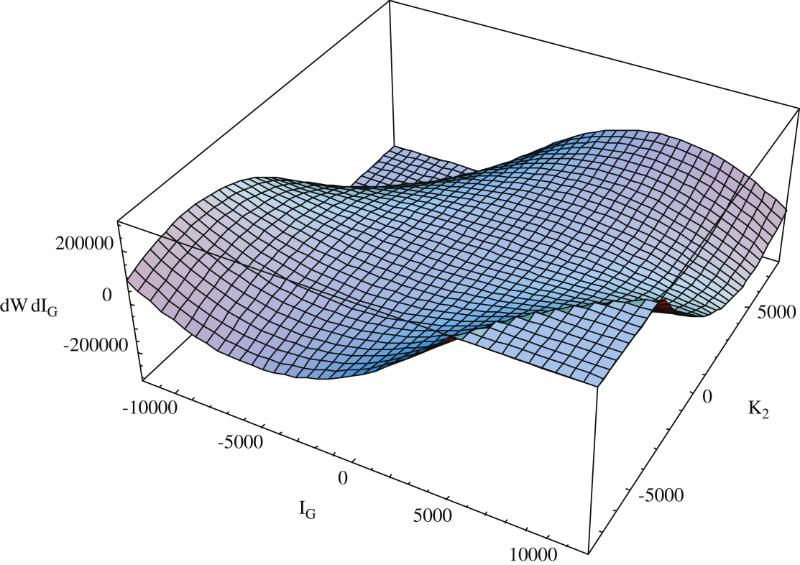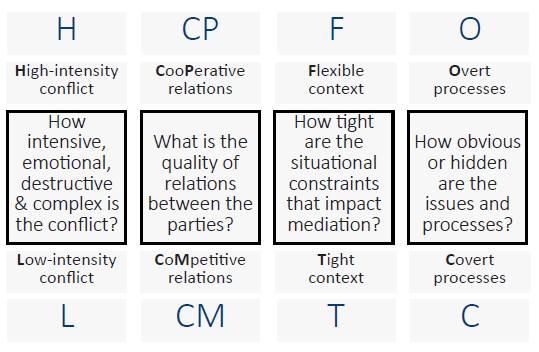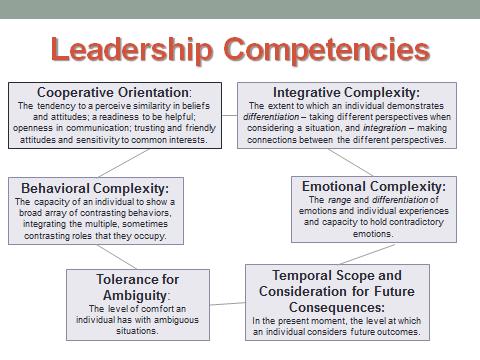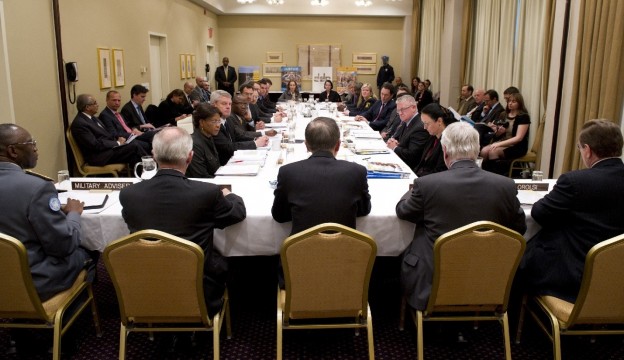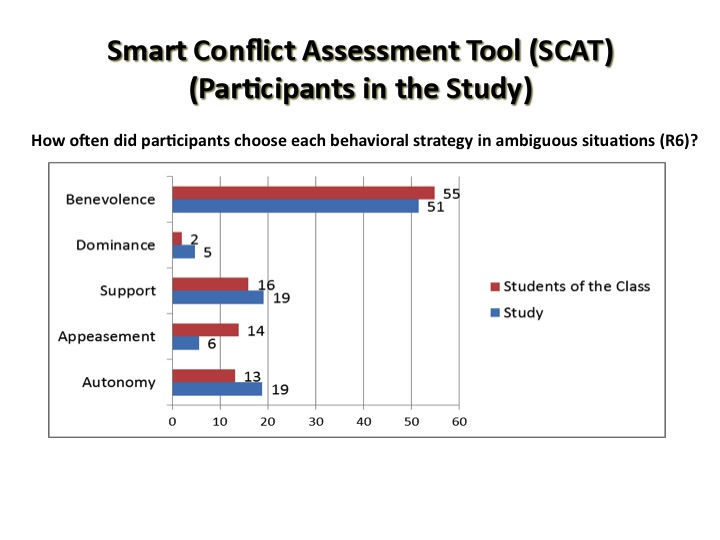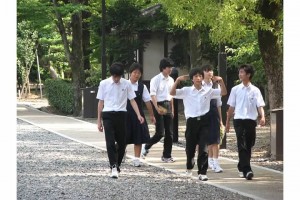Tools and Assesments
As a part of the MD-ICCCR research program, dynamical assessment inventories have been developed to provide feedback to individuals about their reactions, perceptions and behavioral tendencies. Other tools include systems mapping protocols and computer mouse-based technology.
Can't find what you're looking for? Take a look at our Conflict Intelligence Lab website for 11 additional self, social, situational, and systemic assessments.
Destructive conflicts demand attention to the here and now; to the violence, hostilities, suffering and grievances evident in the immediate context. While important, this emphasis often draws attention away from the history, trajectory, and broader context in which the conflict is evolving. Today, many peace-practitioners employ the use of complexity and feedback-loop mapping to re-contextualize their own and the stakeholders’ understanding of the conflict (see Burns, 2007; Coleman, 2011; Körppen, Ropers & Giessmann, 2011; Ricigliano, 2012).
The dynamical system of the conflict – in the form of a dynamic network – can be represented through a series of feedback loop analyses (see Figure 1). Loop analysis, developed by Maruyama (1963, 1982), is useful for mapping reinforcing and inhibiting feedback processes that escalate, de-escalate and stabilize destructive conflicts. Reinforcing feedback occurs when one element (such as a hostile act) stimulates another element (such as negative out-group beliefs) along its current trajectory. Inhibiting feedback occurs when one element inhibits or reverses the direction of another element (such as when guilty or compassionate feelings damper hostilities). Strong attractors are created when reinforcing feedback loops are formed between previously unrelated elements, while inhibiting feedback dissipates in the system.
Feedback mapping not only captures the multiple sources and complex temporal dynamics of conflict systems but can also help identify central nodes and patterns that are unrecognisable by other means. The process typically begins by identifying the key elements in the conflict that emerge during different phases of escalation and specifying the nature of the linkages among these elements. This analysis can be characterized as evolving through various developmental stages (such as phases 1-9 in Figure 1). Maps can be generated at the individual level (identifying the emotional and cognitive links that parties hold in their attitudes, feelings and beliefs – associations related to the problem and to their sense of the other), at the interpersonal level (allies, enemies, power structures and so on.) and at the systemic level (e.g. mapping the feedback loops that allowed a particular series of events to escalate, such as seen in Figure 1). This can be useful for remaining mindful of the systemic context of the conflict and for restoring a sense of complexity into the parties’ understanding of events.
The DST Applied Group is an initiative of AC4 that brings together researchers and practitioners that are using DST or other systemic approaches in research or practice. The goal of the group is to translate the theoretical promise of DST into practical tools to help us better understand and respond to complex conflicts. Tools that members of the group are currently working on include training curricula for students, business executives and political figures, computer simulation models to inform public policy, novel conflict assessment methodologies for workplaces, communities, or societies emerging from conflict, and other projects at the research-practice nexus of systemic thinking and conflict.
To expand this work, the Advanced Consortium on Cooperation Conflict and Complexity (AC4), the International Center for Cooperation and Conflict Resolution (ICCCR) at Columbia University, The Institute of World Affairs (IWA) at the University of Wisconsin, Milwaukee, and the School for Conflict Analysis and Resolution (S-CAR) at George Mason University are supporting the development of an Innovation Lab on Dynamical Systems Theory, Peace and Conflict. The general goals of the Innovation Lab are to create opportunities, structures and support mechanisms to bring together experienced scholar-practitioners working with complexity science, conflict and peace to share leading-edge ideas, methods and practices and to inspire and support collaborative work in this area for moving the work forward.
Publications
The five percent: Finding solutions to seemingly impossible conflicts
By Peter T. Coleman (2011)
One in every twenty difficult conflicts ends up not in a calm reconciliation or tolerable standoff but as an acute and lasting antagonism. Such conflicts—the five percent—can be found among the diplomatic and political clashes we read about every day in the newspaper but also, and in a no less damaging and dangerous form, in our private and personal lives, within families, in workplaces, and among neighbors. These self-perpetuating conflicts resist mediation, defy conventional wisdom, and drag on and on, worsening over time. Once we get pulled in, it is nearly impossible to escape. The five percent rule us.
Attracted to conflict: The emergence, maintenance and transformation of malignant social relations
By Robin Vallacher, Andrzej Nowak, Peter T. Coleman, Lan Bui-Wrzosinska, Larry S. Liebovitch, Katharina Kugler, and Andrea Bartoli (2013)
This book addresses the subject of intractable social conflict from a new vantage point. Here, these types of conflict represent self-organizing phenomena, emerging quite naturally from the ongoing dynamics in human interaction at any scale—from the interpersonal to the international. Using the universal language and computational framework of nonlinear dynamical systems theory in combination with recent insights from social psychology, intractable conflict is understood as a system locked in special attractor states that constrain the thoughts and actions of the parties to the conflict. The emergence and maintenance of attractors for conflict can be described by means of formal models that incorporate the results of computer simulations, experiments, field research, and archival analyses. Multi-disciplinary research reflecting these approaches provides encouraging support for the dynamical systems perspective.
Services, tools, and resources
DST Innovation Lab
Conflict Resolution in Action – Applying Dynamical Systems Theory (video)
One cutting-edge theory that guides many research projects at the ICCCR is the Attractor Landscape Model (ALM), a theoretical framework within the Dynamical Systems Theory framework. In contrast to traditional problem solving models of conflict, ALM places conflicts with a dynamic field of nonlinear dynamic patterns, self-organization, and reinforcing feedback loops. Using ALM allows researchers to see intractable conflicts as “stuck” in destructive interaction patterns, which resist all attempts to reach resolution. Actions take to disrupt one element of the conflict system are quickly thwarted as other elements of the system act to maintain or reestablish the distractive attractor. From the ALM perspective, disrupting an intractable conflict requires first mapping the dynamic patterns and feedback loops that are currently holding the conflict in its current state while also identifying “actionable hubs” where an intervention could serve to disrupt the attractor. Finally, it is not enough to disrupt the attractor without first identifying latent attractors, which are potential alternative (positive) attractor states. In other words, it is not enough to approach a conflict in terms of reducing the likelihood of war – the involved parties must also act to identify and increase the probabilities for peace.
Publications
The five percent: Finding solutions to seemingly impossible conflicts
By Peter T. Coleman (2011)
One in every twenty difficult conflicts ends up not in a calm reconciliation or tolerable standoff but as an acute and lasting antagonism. Such conflicts—the five percent—can be found among the diplomatic and political clashes we read about every day in the newspaper but also, and in a no less damaging and dangerous form, in our private and personal lives, within families, in workplaces, and among neighbors. These self-perpetuating conflicts resist mediation, defy conventional wisdom, and drag on and on, worsening over time. Once we get pulled in, it is nearly impossible to escape. The five percent rule us.
Navigating the landscape of conflict: Applications of dynamical systems theory to protracted social conflict. in Systemic thinking and conflict transformation
By Peter T. Coleman, Robin Vallacher, Andrzej Nowak, Lan Bui-Wrzosinska, and Andrea Bartoli (2013)
Understanding the spread of malignant conflict: A dynamical-systems perspective
By Naira Musallam, Peter T. Coleman and Andrzej Nowak
The dynamics of intractable conflicts have been mainly studied in terms of their qualitative changes, escalations and deescalations, stages, and turning points. Recently, scholars have began to describe another central aspect related to conflict dynamics: the degree to which conflict is capable of spreading beyond the original issues and its ability to transform “conflict-free issues” and organize them into the structure of the conflict. This article refers to this phenomenon as “conflict pervasiveness,” and uses the dynamical systems theory framework to offer a systematic conceptualization of it on psychological, social, and structural levels. This article describes some of the key operating mechanisms of the phenomenon, and illustrates it on the 3 levels using interviews, focus groups, journalings, and available interdisciplinary literature reviews. The article concludes by outlining the utilities of the construct for conflict and peace studies, and summarizes some of the main challenges facing us to better understand and measure conflict pervasiveness.
Rethinking intractable conflict: The perspective of dynamical systems
By Robin Vallacher, Peter T. Coleman, Andrzej Nowak, and Lan Bui-Wrzosinska (2010)
Intractable conflicts are demoralizing. Beyond destabilizing the families, communities, or international regions in which they occur, they tend to perpetuate the very conditions of misery and hate that contributed to them in the first place. Although the common factors and processes associated with intractable conflicts have been identified through research, they represent an embarrassment of riches for theory construction. Thus, the current task in this area is integrating these diverse factors into an account that provides a coherent perspective yet allows for prediction and a basis for conflict resolution in specific conflict settings. We suggest that the perspective of dynamical systems provides such an account. This article outlines the key concepts and hypotheses associated with this approach. It is organized around a set of basic questions concerning in- tractable conflict for which the dynamical perspective offers fresh insight and testable propositions. The questions and answers are intended to provide readers with basic concepts and principles of complexity and dynamical systems that are useful for rethinking the nature of intractable conflict and the means by which such conflict can be transformed.
Attracted to conflict: The emergence, maintenance and transformation of malignant social relations
By Robin Vallacher, Andrzej Nowak, Peter T. Coleman, Lan Bui-Wrzosinska, Larry S. Liebovitch, Katharina Kugler, and Andrea Bartoli (2013)
This book addresses the subject of intractable social conflict from a new vantage point. Here, these types of conflict represent self-organizing phenomena, emerging quite naturally from the ongoing dynamics in human interaction at any scale—from the interpersonal to the international. Using the universal language and computational framework of nonlinear dynamical systems theory in combination with recent insights from social psychology, intractable conflict is understood as a system locked in special attractor states that constrain the thoughts and actions of the parties to the conflict. The emergence and maintenance of attractors for conflict can be described by means of formal models that incorporate the results of computer simulations, experiments, field research, and archival analyses. Multi-disciplinary research reflecting these approaches provides encouraging support for the dynamical systems perspective.
For more information about this project contact Kyong Mazzaro at kmazzaro(at)ei.columbia.edu
This research examines the relationship between individualism-collectivism (IND-COL), conflict management styles and satisfaction. By taking a dynamical systems approach in conceptualizing IND-COL and measuring temporal data, we investigate how different ratios of individualistic-to-collectivistic orientations are associated with different conflict management styles.
In order to measure IND-COL dynamically, we first ask participants to recall and record a conflict that they had at work. Then, they code their stream of consciousness about a conflict on IND-COL using the mouse paradigm (Vallacher & Nowak, 1994). The mouse paradigm registers the position of the computer-mouse for every second of the recorded conversations which allows us to code temporal data. For example, when the participant feels that he had individualistic orientation, he moves the mouse to the left side of the screen and when he feels that he had collectivistic orientation, he moves the mouse the right. Thus, participants code their own stream-of-thought accounts of actual conflicts and this allows us to investigate how different ratios of individualistic-to-collectivistic orientation are associated with differences in conflict management styles.
Results showed that individuals who employed a balanced focus (1:1 ratio) of both individualistic and collectivistic orientations utilized an integrating style more than individuals with either a strong individualistic or collectivistic orientation. Consistent with past literature, individuals with predominant focus on individualism utilized dominating style whereas individuals with predominant focus on collectivism utilized obliging and avoiding styles. We also found that integrating style is associated with satisfaction with conflict outcomes, processes, relationships, goal attainment and job satisfaction at work. Taken together, this study focuses on the re-conceptualization of IND-COL as dynamical features of culture and their effects on conflict management styles and satisfaction at work.
For more information about this project contact Regina Kim at rk2534(at)tc.columbia.edu
Related Publications
Kim, R. and Coleman, P. T. (2015).The combined effect of individualism – collectivism on conflict styles and satisfaction: An analysis at the individual level. Peace and Conflict Studies, 22, Available at: http://nsuworks.nova.edu/pcs/vol22/iss2/3
Through the development of our research agenda on the basic dimensions of mediation and the role of mediator adaptivity, optimality and systemic efficacy in disputant and mediator satisfaction, fairness, efficiency, and sustainability of agreements, we are currently working on developing an advanced mediation toolkit and training. The Mediation Adaptivity Assessment Tool (MAAT) will include: a practical overview of our empirical model, a set of practical tools and questionnaires to categorize mediation-types, mediator competency, adaptivity, and optimality (or the capacity to use the right mediation approach taking into account the basic dimensions of the mediation situation). We are also working on developing case studies and other materials to enhance our educational offerings and training initiatives.
Publications
Putting the Peaces Together: Introducing a Situated Model of Mediation
By Peter T. Coleman, Katharina Kugler, Christianna Gozzi, Kyong Mazzaro, Nora El Zokm, and Kenneth Kressel (in progress)
Although academic research on mediation has progressed considerably over the last few decades, it still faces considerable challenges to its practical relevance. Today, the findings from research on mediation present a fractured, piecemeal understanding of what constitutes “effective mediation” and how to achieve it. Research is typically either micro (e.g., mediator style) and decontextualized from the broader system of conflict management, or macro (e.g., case comparisons) and disconnected from mediator decisions and action. As a consequence, many models of mediation practice are not derived from sound theory or evidence-based research (Coleman, 2011). Knowledge generated within academia oftentimes does not reach practitioners and valuable field experiences and practices rarely inform academia – impeding mutual learning and development (Honeyman, 2009; UN Report, 2012).
Approximately five percent of more difficult conflicts enter into escalating spirals that become increasingly intractable. Scholarship has identified a variety of individual-level and organizational-level variables associated with constructive vs. destructive attractors of organization conflict. At the individual-leader level, cooperative-competitive orientation, levels of integrative, behavioral, and emotional complexity, tolerance for ambiguity, and temporal scope or consideration for future consequences have all been associated with more constructive vs. destructive patterns of disputing. At the organizational level external environment, type of organization, cross-cutting structures, cultural complexity, task-reward interdependence, social structures, and decision-making structures have also been identified. However, there is currently no unifying framework for assessing how various individual competencies and organizational structures work in concert to affect the probabilities for constructive vs. destructive conflict dynamics. This project identifies an approach for assessing conflict competencies and structures at both of these levels.
- Individual-Level Leader Assessment
This portion of the project aims to identify various individual leader competencies that relate to long-term conflict dynamics between individuals in a workplace environment. Participants will first be asked to complete a measure of complex thinking, affect, and behavior and will then participate in an online simulation of a complex social environment. This online agent-based simulation will provide participants with a complex social environment that they must attempt to change (for the better). Our research will investigate how decision-making patterns in the simulation relate to the measures of complexity, and what types of these patterns lead to positive outcomes. This project is currently in the conceptual phase of development in partnership with the Columbia Center for New Media Teaching and Learning (CCNMTL)at Columbia University.
- Development of the Organization Level Framework
The aims of this component of project are twofold. First, we have proposed a conceptual framework for leaders to assess the structure of their organization in terms of facilitating/inhibiting constructive and destructive conflict dynamics (increasing/ decreasing probabilities). Second, we have developed guidelines for leaders to conduct organization-level assessments and to explore relevant outcomes in their organization (e.g. conflict climate, innovation, morale, organization-commitment, and procedural justice). The next steps for this project are currently in the conceptual phase.
Publications
Playing the odds: A multi-level framework for addressing probabilities for intractable conflict at work
By Peter T. Coleman, Nicholas Redding & Lily Ng (under review)
Research has identified a variety of individual-level and organizational-level variables associated with constructive versus destructive patterns of organizational conflict. However, this multitude of variables represents something of an embarrassment of riches. Currently, there is no unifying framework for understanding how individual attributes and competencies and organizational structures and processes work in concert to affect the probabilities for destructive, enduring conflicts. Understanding the genesis, maintenance and transformation of conflict attractors in organizations requires more than an understanding of the individual and contextual factors involved, and must include their inter-relationships, the timescales in which they unfold, and the mechanisms that affect transmission of conflict dynamics from one level to another. This monograph presents such a framework, offering a comprehensive approach for conceptualizing and assessing conflict competencies and structures at multiple levels of organizations.
International mediation is a highly-specialized, demanding job that requires a unique skillset and extensive professional network. While only a small number of individuals use the label of “mediator” to describe their work, professionals in a wide range of settings – academic institutions, NGOs, think-tanks, etc. – may engage in mediation or negotiation as part of other projects or agendas. Vital to effective conflict engagement in these settings is entering with a current and informed sense of the various stakeholders, interveners, and related initiatives happening on the ground.
Although the United Nations and the Department of Political Affairs have concentrated their efforts to provide the Secretary-General, his Representatives, and UN partners actively engaged in peacemaking efforts with general advice and support, information about current mediation networks for effective conflict engagement and intervention is scarce, guarded and piecemeal at best. At the same time, online resources such as UN Peacemaker, which not only include extensive databases of peace agreements but also guidance material and information on the UN’s mediation support services, are becoming an essential tool for actors that are actively engaged in peacemaking efforts globally, including Member States, regional organizations, civil society, non-governmental organizations and national mediators.
To address the need for more online resources on current mediation networks, and capitalizing on already existing online resources and databases, AC4 has been conducting expert interviews and desk research to piece together information about how individuals in these settings gather and use information to advance their work in conflict-affected areas.
Publications
Research Proposal: Expanding Online Mediation Support Tools: Mapping Mediation Networks for Effective Conflict Engagement and Intervention
Putting the Peaces Together: Introducing a Situated Model of Mediation
By Peter T. Coleman, Katharina Kugler, Christianna Gozzi, Kyong Mazzaro, Nora El Zokm, and Kenneth Kressel (in progress)
Although academic research on mediation has progressed considerably over the last few decades, it still faces considerable challenges to its practical relevance. Today, the findings from research on mediation present a fractured, piecemeal understanding of what constitutes “effective mediation” and how to achieve it. Research is typically either micro (e.g., mediator style) and decontextualized from the broader system of conflict management, or macro (e.g., case comparisons) and disconnected from mediator decisions and action. As a consequence, many models of mediation practice are not derived from sound theory or evidence-based research (Coleman, 2011). Knowledge generated within academia oftentimes does not reach practitioners and valuable field experiences and practices rarely inform academia – impeding mutual learning and development (Honeyman, 2009; UN Report, 2012).
Services, tools, and resources
For our measure of conflict adaptivity – the Smart Conflict Assessment Tool (SCAT) – we use the conceptual framework of a situated model of conflict in social relations (Coleman et al., 2012; Coleman et al., 2010; Coleman et al., in press) and our methodological approach to assessment has similarities with the methods developed by Vroom and Yetton for assessing tendencies regarding their contingency model of leadership behavior (Vroom & Yetton, 1973; Vroom & Yago, 1978).
The goal of the measure is to assess individual differences in adaptivity of managers when dealing with conflicts at work. The SCAT asks participants to imagine themselves in 15 categorically different conflict situations (3 scenarios for each of the 5 regions of the model; see Figure 1). Then the participant is asked to indicate how he/she would respond to the situation, choosing one of 5 behavioral strategies. The behavioral strategies represent the 5 distinct behavioral responses that correspond to the 5 regions (see Figure 1): benevolence, dominance, support, appeasement, autonomy. A degree of feasibility is determined for a participant’s response to each situation. The average across all scenarios constitutes the adaptivity score.
Publications
Tracking adaptivity: Introducing a dynamic measure of adaptive conflict orientations in organizations
By Peter T. Coleman and Katharina Kugler (under review)
Since Darwin, adaptation to change has been associated with survival and fit. Yet despite this, leaders and managers often get stuck in dominating approaches to conflict, and few scholars have examined the role of adaptation in managing conflicts effectively over time and across changing situations. Four studies are presented based on a situated model of conflict in social relations, which contribute to the development of a new measure (the Smart Conflict Assessment Tool – SCAT) for assessing conflict adaptivity at work. The model suggests that more adaptive approaches to conflict – those that allow for the use of varied strategies that are in line with the demands of situations and effectively meet disputant’s needs– will result in higher levels of satisfaction with conflict and work. Results support our hypotheses. Individuals who responded to fundamentally different conflict scenarios in a manner not inconsistent with the demands of the situations they faced reported higher levels of general satisfaction with conflict processes, relationships and outcomes at work, and with greater work satisfaction. Limitations and implications of the research are discussed.
Services, tools, and resources
- Implicit Power Theory and Scale
- Organizational Power Practices Framework
For more information about this project contact Kyong Mazzaro at kmazzaro(at)ei.columbia.edu
Most social conflicts (and particularly the more difficult ones) are up and down the hierarchy of power and authority. They can take place in different settings, from families, to organization, communities, nations and entire countries. In this project, we are working on characterizing and developing tools and assessments, based on decades of research and practice, taking into account a specific set of strategies that have proven to be key in navigating and managing social and organizational conflict.
We have identified seven main conflict management strategies: Support, Appeasement, Autonomy, Dominance, Benevolence, Compete and Cooperate. To these we add Adaptivity, the ability to leverage all of the different strategies when necessary, and Revolution, the capacity to break the rules as a last resort. The main objective of this project is to identify and test 1) the personal, developmental and cultural tendencies that draw people to the strategy, 2) its values, benefits and merits (when it’s good and should be used), 3) a catalogue of artful tactics that can be learned and employed, 4) the consequences of using the strategy too much or inappropriately (what happens when it gets stuck), and 5) the competencies and skills needed to develop and employ the strategy effectively.
Our approach stresses the importance for leaders of developing the capacity to adapt: to be able to employ various strategies and tactics for conflict management and influence effectively in organizations – in order to marshal their potential energy and avoid pitfalls.
Publications
Conflict Intelligence: Harnessing the Power of Conflict and Influence
By Peter Coleman and Robert Ferguson (forthcoming)
Research has found that although many negotiators and leaders tend to get stuck in one approach to negotiating conflict (often domination), our more effective leaders and negotiators are more nimble. They read situations more carefully, consider their short and longer-term objectives, and then employ a variety of different strategies in order to increase the probabilities that their agenda will succeed. Our upcoming new book, Conflict Intelligence: Harnessing the Power of Conflict and Influence provides step-by-step instructions for developing skill in applying these strategies and tactics and enhancing competencies for adaptivity in conflict.
Power and Conflict
In The Handbook of Conflict Resolution: Theory and Practice, 3rd Edition
By Peter T. Coleman (forthcoming)
Tracking adaptivity: Introducing a dynamic measure of adaptive conflict orientations in organizations
By Peter T. Coleman and Katharina Kugler (under review)
Since Darwin, adaptation to change has been associated with survival and fit. Yet despite this, leaders and managers often get stuck in dominating approaches to conflict, and few scholars have examined the role of adaptation in managing conflicts effectively over time and across changing situations. Four studies are presented based on a situated model of conflict in social relations, which contribute to the development of a new measure (the Smart Conflict Assessment Tool – SCAT) for assessing conflict adaptivity at work. The model suggests that more adaptive approaches to conflict – those that allow for the use of varied strategies that are in line with the demands of situations and effectively meet disputant’s needs– will result in higher levels of satisfaction with conflict and work. Results support our hypotheses. Individuals who responded to fundamentally different conflict scenarios in a manner not inconsistent with the demands of the situations they faced reported higher levels of general satisfaction with conflict processes, relationships and outcomes at work, and with greater work satisfaction. Limitations and implications of the research are discussed.
Getting down to basics: A situated model of conflict in social relations
By Peter Coleman, Katharina Kugler, Lan Bui-Wrzosinska, Andrzej Nowak, and Robin Vallacher (2012)
The field of conflict resolution is fractured. Despite many decades of fine research, we still lack a basic unifying framework that integrates the many theories of conflict dynamics. Thus, the findings from research on conflict are often piecemeal, decontextualized, contradictory, or focused on negative outcomes, which contributes to a persistent research-practice gap. In this article, we describe a situated model for the study of conflict that combines separate strands of scholarship into a coherent framework for conceptualizing conflict in dyadic social relations. The model considers conflict interactions in the context of social relations and employs prior research on the fundamental dimensions of social relations to create a basic framework for investigating conflict dynamics. The resulting model is heuristic and generative. We discuss the theoretical context and main propositions of this model as well as its implications for conflict resolution practitioners.
Services, tools, and resources
- Implicit Power Theory and Scale
- Organizational Power Practices Framework
For more information about this project contact Kyong Mazzaro at kmazzaro(at)ei.columbia.edu
Through the development of a cultural Integration-Adaptation Model (I-AM), we have identified a set of relevant micro and macro skills and practices to enhance integration and adaptation in multicultural conflict. The model integrates the aims, values and strategies of both the cultural approach to conflict management, which emphasizes the harmonious navigation of difference in conflict, with the multicultural approach, which champions notions of equity, justice and fairness in disputes. It does so by highlighting the core competencies and strategies needed for managing multicultural conflict in both a just and constructive manner. Thus, the core foci of the model are fairness and fit.
We elaborate on a set of micro and macro skills, processes and structures that research has identified as enhancing the core components of the I-AM Model, or the 4-As that lead to Integration-Adaptation:
- Awareness of cultural assumptions, cultural rules, racial/ethnic identity, privilege, class, and other components of the worldview of self and others.
- Accuracy in reading situations, valuing data and not giving in to preconceived theories, beliefs and stereotypes regarding multicultural dynamics and conflict.
- Adaptivity requiring cognitive, emotional, and behavioral flexibility in responding to multicultural conflict.
- Accountability to self, other, and community, through reading feedback and synchronizing with the other.
Publications
Multiculturalism and Conflict
In The Handbook of Conflict Resolution: Theory and Practice, 3rd Edition
By Mekayla Castro & Peter T. Coleman (forthcoming)
In this chapter we offer an introduction to the relationship between multiculturalism, conflict and conflict resolution. First, we present an overview of multiculturalism – the “good”, the “bad”, and the relevant – including its contribution to our understanding of conflict theory and conflict management, how it compares and contrasts with the study of culture and conflict, and the limitations of both multicultural and cultural perspectives. We end the first section with a review of the empirical literature on multiculturalism and conflict-relevant outcomes and resolutions. We devote the second part of the paper to the presentation of the Integrity-Adaptivity Model (I-AM), an integrated approach to managing multiculturally-based conflicts that builds on applications of multiculturalism in education, counseling, and organizational development. In conclusion we offer a summary and suggestions for the research and practice of multiculturally-sensitive conflict analysis, management, and resolution.
Over the past few decades, psychologists have become increasingly aware of the limitations of using explicit self-report measures to assess motives, attitudes and opinions particularly with regard to socially sensitive issues. This is due to the challenges posed by both the desire of respondents to appear reasonable and thus answer survey questions in socially desirable ways, as well as their common lack of awareness of their own attitudes regarding the specific objects being evaluated. This is particularly true in areas of protracted conflict, where citizens have been raised and socialized in war. Under such conditions, simply asking people about their motives through surveys or focus groups fails to get beyond their “automatic mental programming” (what they have been conditioned to say) in order to identify what specifically would motivate them to act.
Rule Development Experimentation (RDE) was developed to circumvent such programming and help identify the clusters of motives or mindsets which drive different behaviors. The RDE tool combines several statements into short vignettes and enables each respondent to see and rate each vignette as a whole description. The tool then splits the respondents into 2 or more mind-type segments based on the similarity of their answers through a cluster analysis. This methodology has been applied successfully to important societal problems such as what to say to different mind-type groups of high school students to dissuade them from bullying other students and what type of information to provide different groups of ER cardiac patients to best ensure compliance with prescribed treatments.
Decades of research on mind-types through RDE has found that often a high motivator for one segment is an equally large de-motivator for a different segment. Therefore, without knowing which segment a particular person belongs to, it is quite difficult to know what to say and what not to say to motivate behavior. In response, the RDE team developed a data analytic strategy called Segmentation Wizard. Utilizing Discriminant Function Analysis, the RDE software generates a series of 3-5 questions, the answers to which identify with 70-90 % accuracy which segment a given respondent belongs to.
Publications
‘Mind genomics’: the experimental, inductive science of the ordinary, and its application to aspects of food and feeding
By Howard Moskowitz (2012)
The paper introduces the empirical science of ‘mind genomics’, whose objective is to understand the dimensions of ordinary, everyday experience, identify mind-set segments of people who value different aspects of that everyday experience, and then assign a new person to a mind-set by a statistically appropriate procedure. By studying different experiences using experimental design of ideas, ‘mind genomics’ constructs an empirical, inductive science of perception and experience, layer by layer. The ultimate objective of ‘mind genomics’ is a large-scale science of experience created using induction, with the science based upon emergent commonalities across many different types of daily experience. The particular topic investigated in the paper is the experience of healthful snacks, what makes a person ‘want’ them, and the dollar value of different sensory aspects of the healthful snack.
Implicit prejudice and stereotyping: How automatic are they? Introduction to the special section
By Patricia G. Devine (2001)
This special issue of the Journal of Personality and Social Psychology: Attitudes and Social Cognition addresses issues of the measurement and the malleability of implicit prejudice and stereotypes. The findings raise fundamental questions about the assumptions underlying the assessment of implicit prejudice, particularly with regard to the widely used Implicit Association Test (A. Greenwald, D. McGhee, & J. Schwartz, 1998) and the assumption of extant models of prejudice and stereotyping that implicit biases are automatically and invariantly activated when perceivers come in contact with members of stigmatized groups.
Implicit social cognition: Attitudes, self-esteem and stereotypes
By Anthony G. Greenwald and Mahzarin R. Banaji (1995)
Social behavior is ordinarily treated as being under conscious control. However, considerable evidence now supports the view that social behavior often operates in an unconscious fashion. The identifying feature of implicit cognition is that past experience influences judgment in a fashion not introspectively known by the actor. The present conclusion—that attitudes, self-esteem, and stereotypes have important implicit modes of operation—extends both the construct validity and predictive usefulness of these major theoretical constructs of social psychology. Methodologically, this review calls for increased use of indirect measures—which are imperative in studies of implicit cognition.

